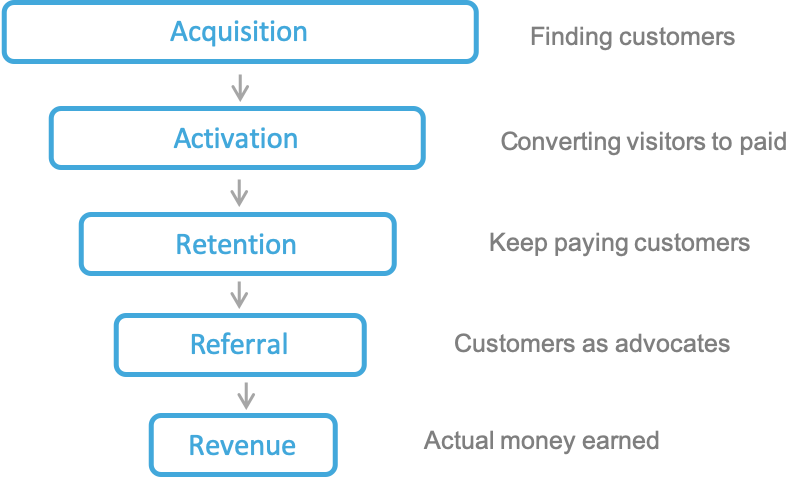What is the Pirate Metric? (AARRR)
Often coined the “Pirate Metric”, AARRR is a 5 step metric created by Angel investor and founder of startup accelerator 500 startups, Dave McClure. The metric is often called the Pirate Metric because the acronym makes that of a pirates sound…AARRR which stands for Acquisition, Activation, Retention, Referral, and Revenue. The metric that McClure created has become a common measurement of a startup’s growth, using five key performance indicators.

The Five Steps of AARRR
AARRR allows you to set valuable and actionable metrics for your product right from the start, while also allowing you to measure your customers’ growth.
Acquisition – The first and most important metric is acquisition which refers to acquiring new customers. If you don’t have new customers, you cannot grow the business, or replace naturally ending subscriptions. At this stage your customers are leads and they are actively vetting your product to determine if they will return. A good metric to consider here is Cost per Lead (CPL).
Activation – Activation refers to the moment when your customer decides they love your product and want to become a repeat customer. With good instrumentation, you should be able to tell where the tipping point is for the majority of your users. From there you can highlight this feature so that you can speed up the activation process with new users. A couple of good metrics to track for activation are Customer Acquisition Cost (CAC) so you know exactly how much to spend profitably, and Conversion Rate by Channel, so you have a better sense of exactly where your paying customers are coming from, what’s motivating them.
Retention – Retention is the measurement of how many of your customers return and how often. The success of a good product can ultimately be determined by the percentage of customers that return. A good metric here might be the average length of subscription. The goal is to reduce “churn” and keep those customers engaged and paying for your product, as long as possible.
Referral – There are two types of referrals – earned organic referrals (such as word of mouth and natural inbound links), and paid that come from incentives and compensation. Potential customers are more inclined to try a new product or service if they have a positive referral from someone they trust (earned). Additionally, the new customer will spend more time with your product in the initial stage if a colleague or friend recommended your product allowing for a greater chance of reaching the activation and retention stage. A good metric here would be monthly referrals by channel (search, social, invites, etc).
Revenue – How much money are you making, before expenses? This is likely a metric you’ll derive from your BI tools, not from a web analytics platform. Backing out charge-backs and accounting for pro-rated new subscriptions during the month, how much topline revenue did you book for the month? Other good metrics to consider here are Average Order Value (AOV) and Average Selling Price (ASP), to get a little deeper insight.
Measuring your Success
The Acquisition and Activation phases both require various forms of measurement to determine your users’ likelihood of retention. The four most common forms of measurement are:
Qualitative – This refers to watching your users while they navigate through your product and determine problems and solutions with a small number of users.
Quantitative – Tracking users and their conversion rates as well as user engagement
Comparative – Often referred to as A/B testing which is comparing a users journey in one scenario vs another scenario before finalizing your product
Competitive – Monitoring your competitors and comparing their product against your product.
In Summary
Ultimately the goal is to develop a successful product, and AARRR has proven to be a simple and straightforward metric to help determine the likelihood of the success of your product early on so that you can measure and iterate until your product is successful. As McClure himself said, the AARRR metric is about less and not more.


